Services on Demand
Journal
Article
Indicators
-
 Cited by SciELO
Cited by SciELO -
 Access statistics
Access statistics
Related links
-
 Cited by Google
Cited by Google -
 Similars in
SciELO
Similars in
SciELO -
 Similars in Google
Similars in Google
Share
Revista Facultad Nacional de Agronomía Medellín
Print version ISSN 0304-2847
Rev. Fac. Nac. Agron. Medellín vol.64 no.2 Medellín July/Dec. 2011
Electronic Coffee Grains Separator
Separador Electrónico de Granos de Café
Juan Rodrigo Sanz-Uribe1; Jenny Paola Pabón-Usaquén2; Julián Andrés Cardona-Duque3; Paula Jimena Ramos-Giraldo4 y Carlos Eugenio Oliveros-Tascón5
1 Investigador Científico II. Centro Nacional de Investigaciones de Café -; CENICAFÉ. Sede Planalto, km 4 vía antigua Chinchiná -; Manizales, Manizales, Colombia. <juanr.sanz@cafedecolombia.com>
2 Investigador Asociado. Centro Nacional de Investigaciones de Café -; CENICAFÉ. Sede Planalto, km 4 vía antigua Chinchiná -; Manizales, Manizales, Colombia. <jenny.pabon@cafedecolombia.com>
3 Coordinador Diseño Mecanico. ABB Ltda. - Calle 16 No 15-124 Zona Industrial La Popa, Dosquebradas - Colombia. <julian.cardona@co.abb.com>
4 Investigador Científico I. Centro Nacional de Investigaciones de Café -; CENICAFÉ. Sede Planalto, km 4 vía antigua Chinchiná -; Manizales, Manizales, Colombia. <paula.ramos@cafedecolombia.com>
5 Investigador Principal. Centro Nacional de Investigaciones de Café -; CENICAFÉ. Sede Planalto, km 4 vía antigua Chinchiná -; Manizales, Manizales, Colombia. <carlos.oliveros@cafedecolombia.com>
Recibido: Agosto 23 de 2011; aceptado: Octubre 31 de 2011.
Abstract. Accurate coffee sorting is a response to pressures for product quality and to a growing market for specialty coffees. One of the major challenges in this regard is to prepare the raw coffee fruits for sorting in one-by-one electronic machines. In this paper, we present a mechanical device developed to separate clusters and impurities from the main process. The mechanical device consists of two inclined belt conveyors with upward motion, working in series. This arrangement conveys upwards any elements with more than three contact points on the belt's flat surface, while quasi-spherical elements (fruits) roll down on the belts. The experimental set up was designed to allow each belt's inclination and speed to vary, in order to run a 3 x 3 factorial treatment design (Three inclinations: 10º, 14º and 18º and three speeds: 0.17, 0.20 and 0.24 m s-1). The belt transport surface material was PVC. The best performance was obtained at the speed of 0.20 m s-1 and between 10º and 14º of inclination. After these findings, three treatments were conducted at a working speed of 0.20 m s-1 and three inclinations between 10º and 14º, finding the best performance at 11º. In these conditions the mean efficacy of separation was 98.8%, varying within a range between 97.5% and 100%. The resulting system from this research work is suitable to run as pretreatment of one-by-one electronic sorters of coffee and coffee-like products.
Key words: Agro industrial machinery, raw material preparation, separation of clusters, automation.
Resumen. La clasificación precisa del café surge como respuesta a las exigencias de calidad del producto en los crecientes mercados de cafés especiales. Uno de los retos más importantes al respecto, es la preparación de los frutos del café en bruto para que sean clasificados uno por uno por las máquinas electrónicas. En este trabajo se presenta un dispositivo mecánico desarrollado para separar glomérulos y las impurezas del proceso principal. El dispositivo mecánico consiste en dos cintas transportadoras inclinadas con movimiento ascendente, trabajando en serie. Este mecanismo conduce hacia arriba todos los elementos con más de tres puntos de contacto en una superficie plana de la banda, mientras que los frutos que son cuasiesféricos bajan por las bandas. El trabajo experimental fue diseñado con el fin de determinar la inclinación de cada banda y las variaciones en la velocidad; se ejecutó un diseño 3 x 3 de tratamiento factorial (tres inclinaciones: 10º, 14 º y 18º y tres velocidades: 0,17, 0,20 y 0,24 m s-1 ). La superficie de las bandas transportadoras fueron elaboradas en PVC. El mejor comportamiento se obtuvo con la velocidad de 0,20 m s-1, y entre 10° y 14° de inclinación. Después de estos resultados, los tres tratamientos se llevaron a cabo a una velocidad de trabajo de 0,20 m s-1 y tres inclinaciones entre 10° y 14° encontrándose el mejor desempeño a los 11º. En estas condiciones, la eficacia media de la separación fue del 98,8%, variando en un rango entre 97,5% y 100%. El resultado de este trabajo de investigación es adecuado para funcionar como pre-tratamiento de tipo de electrónico para clasificadoras de café y productos derivados de éste.
Palabras clave. Maquinaria agroindustrial, preparación de materias primas, separación de grupos, automatización.
Coffee is important for Colombia not only because it is the agricultural product that gives the greatest income to the country but also because more than 500.000 families depend on this crop.
Since the average coffee farm in Colombia has an area of only 1.31 ha (Federación Nacional de Cafeteros, 2010), most of the coffee growers are small-farm owners with a small-profit business. One factor that has helped growers to improve their income is the production of coffees with differentiated characteristics, attributed to special environmental effects such as climate, soil, agricultural labors, selective harvesting, special cares and/or processing conditions. As a result, the market for specialty coffees has constantly grown in the way shown in Figure 1.
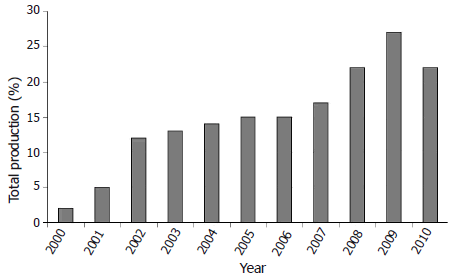
Figure 1. Percentage of the total production in specialty coffees in Colombia (Federación Nacional de Cafeteros, 2010).
Even though harvesting is done manually by coffee pickers who carefully detach and collect the ripe fruits one by one, it is difficult for the coffee growers to receive a homogeneous raw material. The main reason for this heterogeneity is the wide bimodal crop distribution that generates the presence of fruits in all maturation stages during the whole year, which in turn causes pickers to accidentally detach undesired fruits. Another factor that promotes this problem is harvesting passes have to be spaced at the beginning and end of the crop for low offer of fruits, leading to overmature and dry fruits to appear in the harvested fruits. A diverse raw material also affects the consistency of the product.
Some devices have been developed for improving the raw material by density. A very common device is the siphon tank, which permits the precipitation in water of dense fruits that are extracted from the bottom through a siphon pipe; while light fruits and impurities are removed by flotation. A recent development is the Hydraulic Separator with Hopper and Screw Conveyor (HSHSC) (Oliveros et al., 2009), in which the principle of precipitation in water is also used to eliminate low quality fruits and impurities, with less water consumption. However, these hydro-mechanical devices are not able to remove all the undesired fruits.
In order to improve the product consistency, or help in the preparation of special raw materials, a low-cost electronic analyzer able to identify coffee fruits in up to five different maturation stages was developed (Sanz et al., 2008; Oliveros, 2008; Ramos, 2008). The electronic analyzer was also intended for sorting mechanically harvested coffee, because there is a motivation for developing machines for this purpose in order to reduce production costs.
One of the major challenges for the use of electronic sorters is the fruits have to be fed in one-by-one way to be analyzed. In that way, presence of clusters of coffee fruits, as well as impurities, cause machine stops and interfere in its performance.
The purpose of this research work was to develop a simple machine to remove clusters from the main mass of coffee. The machine can be used also to separate impurities, such as leaves and steams that can interfere in the electronic analysis. This paper presents the description of the principle used to achieve the separation and the steps followed in the design, construction and evaluation, as well as the results obtained.
MATERIALS AND METHODS
Preliminary tests. The equipment developed for separating clusters of coffee fruits is based on the principle that any element is in stable equilibrium in a flat surface if it has three or more contact points.
Since coffee fruits are quasi-spherical, they are in unstable equilibrium because every fruit has just one contact point on the flat surface. In contrast, a cluster of fruits stays in equilibrium because has three or more contact points. If the flat surface is inclined to a certain angle, fruits roll down by gravity while clusters remain on the flat surface. If the angle is steeper, it can reach a condition at which clusters start to slide down the flat surface. Very steep angles can make clusters roll.
The principle was originally tested in an inclined belt conveyor moving upwards, but some fruits were retained by clusters and did not let them roll down. To avoid this problem another inclined belt conveyor was added at a lower level, moving upwards as well, to let trapped fruits fall first, and roll down on the lower belt, as shown in Figure 2. The belts used are of the brand Habasit and reference UV15MR, where transport surface is made of PVC. Impurities like dirt, parts of leaves, parts of fruit skin and pulped fruits are conveyed like clusters. Coffee fruits are received in the lower part of the machine and clusters of fruits, as well as impurities, are discharged in the upper part.
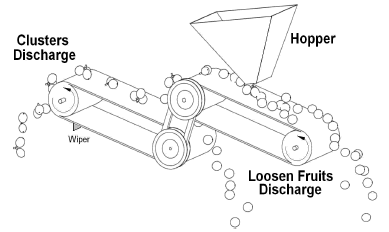
Figure 2. Physical principle used to separate clusters of coffee fruits.
A preliminary trial and error search determined a range which contained the optimal inclination. Twelve tests were conducted using 50 kg of coffee fruits of which contents of clusters were quantified. The belt's inclination was kept at 16º with respect to the horizontal and the speed was varied between 0,18 and 0,51 m s-1 Table 1 shows the results of the 12 preliminary tests.
Table 1. Preliminary tests at 16° of a inclination and different belt speeds in a cluster coffee fruits separating equipment.
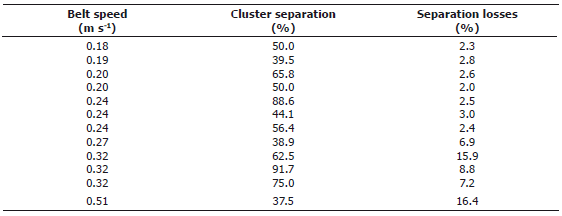
It was found that the separation of clusters varied between 37.5% and 91.7% and the separation losses, defined as loose fruits within the separated clusters divided by the initial mass, between 2.0% and 16.4%. These tests evidenced the necessity of varying the belts speed and the feeding rate.
Table 2 shows the results of running the belt at an inclination of 17º and a speed of 0.19 and 0.20 m s-1. It was noticed a negative effect on the efficacy of separation of clusters and a positive effect on the separation losses.
Table 2. Preliminary tests at 17° of inclination and a speed of around 0.2 m s-1 in a cluster coffee fruits separating equipment.

In the runs it was also noticed impurities such as parts of skin, parts of leaves, dirt and pulped fruits adhered to the belts. This feature can be used as an advantage because those impurities can be easily removed with wipers.
Experimental setup. In order to achieve a constant feeding rate, the Hydraulic Separator with Hopper and Screw Conveyor (HSHSC) developed by Oliveros et al. (2009) was adapted to feed the belts and calibrated to give 300 kg h-1 of coffee fruits, ±10 kg, which is the feeding rate required by the electronic analyzer. This hydro-mechanical device assures a raw material with less bored coffee fruits, and free of dry vane fruits and light impurities.
Since the feeding rate is maintained with the use of the HSHSC, the structure was designed to change the inclination of the belts and the electric motor was driven by a variable-frequency drive in order to change the belts speed. Figure 3 shows a picture of the experimental setup.
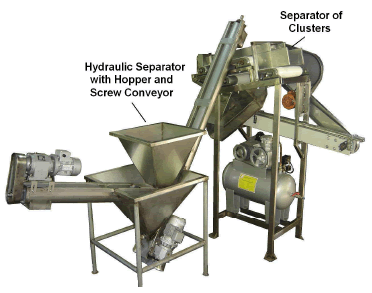
Figure 3. Experimental setup of a cluster coffee fruits separating equipment.
Methodology. The tests were conducted in the National Research Center of Coffee - Cenicafé, located in the city of Chinchiná -; Colombia, at an altitude of 1,310 masl, with a mean temperature of 21.4 ºC and a mean relative humidity of 82.5%.
The experimental design was a 3 x 3 factorial design, with three inclinations (10°, 14° and 18°) and three speeds (0.17, 0.20 and 0.24 m s-1), for a total of nine treatments. Every treatment was repeated four times. The experimental unit consisted of 250 kg of coffee fruits of the Castillo variety®.
In each run the content of clusters of the experimental unit was measured in 1.0 kg samples, which corresponded to the initial content of clusters. The response variables were the final content of clusters, the mass of coffee separated as clusters and the loosened fruits within the separated clusters. These response variables then determined the efficacy of cluster separation and the separation losses.
The efficacy was calculated by the ratio between the final content of clusters, cf, divided by the initial content, ci, as expressed in equation 1.

The separation losses, l, were calculated dividing the mass of loosened fruits within the separated clusters, ll, by the initial mass of loose fruits, l0, as seen in equation 2.

The average and standard deviation of every variable were obtained.
RESULTS AND DISCUSSION
The mean content of clusters in the initial mass was 2.0% with a standard deviation of 1.0%, a maximum value of 4.3% and a minimum of 0.9%. This corresponds approximately to a mean of 7 clusters per kg, with a maximum value of 11 and a minimum value of 4. Figure 4 shows a picture of the clusters found in the mass of coffee fruits. In the picture it can be seen that the clusters have fruits in all the maturation stages.
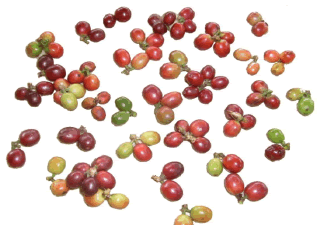
Figure 4. Clusters of coffee fruits found in the harvested coffee.
Table 3 shows the means for the cluster separation efficacy and separation losses for the nine treatments as well as their standard deviations. The greatest values of efficacy of separation were found at the inclinations of 10º and 14º. Even though the separation losses were null for the inclination of 18º, the results for the variable efficacy of separation were very low.
Table 3. Efficacies and separation losses for the separator of clusters of coffee fruits for different belts inclinations and speeds.

The very best result was obtained at a speed of 0.20 m s-1 and the best operation condition between 10 and 14º. For theses reasons three other treatments for inclinations of 11º, 12º and 13º, were conducted at the speed of 0.2 m s-1. Table 4 shows the results for cluster separation efficacy and separation losses. The best results were obtained for the inclination of 11º at a speed of 0.2 m s-1. At these conditions, it was obtained an efficacy of separation of clusters of 98,8% with separation losses of only 0.13%. The mean efficacy was a result of repeated values for the cluster separation efficacy of 100% and a minimum of 97.5%.
Table 4. Efficacies and separation losses for belts inclinations of 11º, 12º and 13º, at a belts speed of 0,2 m s-1.

CONCLUSIONS
The best result was obtained at the inclination of 11º and a speed of 0.2 m s-1. These conditions obtained a cluster separation efficacy of 98.8% with separation losses of only 0.13%.
It was also observed that impurities such as parts of fruits skin, parts of leaves, dirt and pulped fruits can be also removed with this mechanical device leaving the coffee fruits free of dirt.
The system resulting of this research work is suitable to run as pretreatment of one-by-one electronic sorters of coffee.
The knowledge acquired in this research work can be used in other agricultural products that also have problems with clusters.
ACKNOWLEDGMENTS
The authors would like to thank the National Science Foundation of Colombia -; Colciencias, and the National Federation of Coffee Growers of Colombia for economic support for this research project. The authors are also grateful to the people at the machine shop of the Department of Agricultural Engineering at Cenicafé and to the company Luque Internacional for donating the belts.
BIBLIOGRAPHY
Federación Nacional de Cafeteros de Colombia. Informe Gerencia General 2010. Santafé de Bogotá. 156 p. [ Links ]
Oliveros, C.E., J.R. Sanz, E.C. Montoya y E.L. Moreno. 2009. Dispositivo hidráulico de bajo impacto ambiental para limpieza y clasificación del café cereza. Cenicafé 60(3): 229-238. [ Links ]
Sanz, J.R., P.J. Ramos and C.E. Oliveros. 2008. Chapter 20: Algorithm to identify maturation stages of coffee fruits. pp. 167-174. In: IAENG transactions on electrical and electronics engineering. Volume I. IEEE Computer Society, California, USA. 295 p. [ Links ]
Oliveros, C.E., 2008. Máquina seleccionadora de frutos de café. Informe Técnico Final. Proyecto Colciencias: 2251-07-18438. Santafé de Bogotá. 77 p. [ Links ]
Ramos, P.J., 2008. Diseño, construcción y evaluación de un sistema de identificación de estados de maduración de frutos de café a altas velocidades. Tesis Magíster en Ingeniería Eléctrica. Facultad de Ingeniería Eléctrica. Universidad Tecnológica de Pereira. Pereira. 1 CD-ROM. [ Links ]














